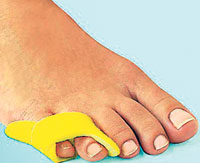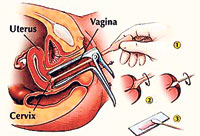Small toe can be a big pain
The American Academy of Orthopaedic Surgeons offers these suggestions to help ease the pain and speed healing of a broken toe:
- Any fracture, confirmed or suspected, should be evaluated by a physician.
- Try not to walk on the toe and keep your weight off the foot as much as you can.
- Place an ice pack on the toe to minimize swelling and pain. Make sure the ice isn't directly on the skin and that you don't leave the ice on for more than 20 minutes at a time.
- Take an over-the-counter painkiller, such as aspirin or ibuprofen.
- Choose a wide shoe with a firm, supportive sole.
- No exercise, sports or activities until the toe heals, especially the activity that caused the break. Swimming is a good alternative until your toe is feeling better.
Are they getting enough iron?
Young children are at great risk for iron deficiency because of rapid growth and increased iron requirements, according to the U.S. Centers for Disease Control and Prevention.
Iron deficiency can occur because of a lack of iron in the diet. Anaemia is the result of a relatively severe deficiency.
Although an inadequate dietary intake of several nutrients may reduce the production of red blood cells and haemoglobin, the most common cause of anaemia throughout the world is iron deficiency.
Poverty, abuse and living in a home with poor household conditions also place children at risk for iron-deficiency anaemia. Iron-deficiency anaemia is seen most commonly in children aged six months to threeyears old. Those at highest risk are low birth-weight infants after two months of age, breast-fed term infants who receive no iron-fortified foods or supplemental iron after four months of age and formula-fed term infants who are not consuming iron-fortified formula.
As babies move to solid foods, foods with high amounts of iron should be selected. These include most meats, egg yolks and certain vegetables, such as spinach.
Iron-deficiency anaemia significantly impairs mental and psychomotor development in infants and children. Although iron deficiency can be reversed with treatment, the reversibility of the mental and psychomotor impairment is not yet clearly understood. Thus, prevention and treatment need to be emphasized.
Pap test: Who needs one and when
A pap test (pap smear) collects a sample of cells from the cervix to look for any abnormalities or changes. It's often used to help diagnose infections or cervical cancer.
The National Women's Health Information Center offers these guidelines for whom should have a pap test and how often:
- Women younger than age 30 should get an annual pap test.
- Women age 30 and older with three consecutive annual pap tests with normal results should get a new test every two-to-three years, with their doctor's approval.
- Women aged 65 to 70 with no abnormal pap tests in the last 10 years may no longer need the test, but should confirm this with their doctors.
- An annual pap test is needed for any woman regardless of age who has a compromised immune system, is HIV-positive, or whose mother was exposed to a chemical called DES (diethylstilbestrol) during pregnancy.
|



